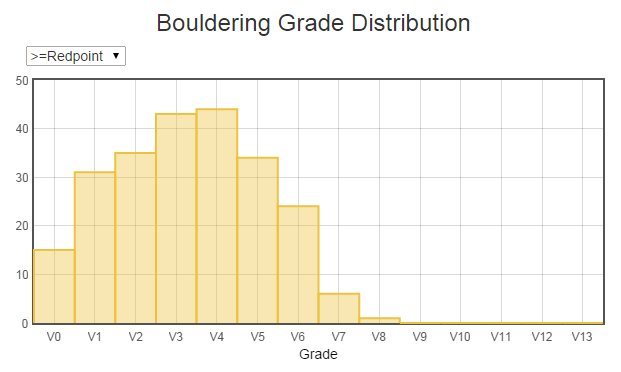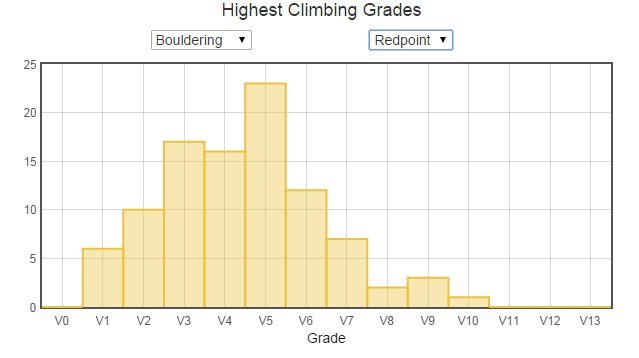The Nerdy Joy of Tracking Your Training
|
|
I posted this over on the Rock Prodigy/Rock Climber's Training Manual forum, but figured I would share here too. The first 8 workouts were on the 10 second hang, 5 second rest. The remaining workouts are on the 7 second hang, 3 second rest. Grey cells denote workouts yet to happen. I’ll explain the volume calculation in a moment. The next plot shows the strength progression (including the planned progression): The weight added and planned final values were based on how my fingers felt at the end of the last session. I found the 2-finger pocket to particularly painful and one that should be ramped up slowly. Now, comparing whole workouts to “volume”: Note that by decreasing my TUT, the volume has decreased. The formula is essentially the sum of the workouts (6 total) where the volume of each individual workout is the equivalent of my body weight plus any added weight (or subtracted) multiplied by the time under tension. I’m currently on the “basic” hangboard regimen with 6 hangs per set at the same weight. We’ll see how this season’s hangboard progresses. I’m debating between adding a 7th grip, a 7th hang for each set, or ramping up weight. Power (Campus Board): Again, I’ve had to compensate for my gym. I do not have route setting privileges and many of the routes are insanely hard for multiple moves or too easy. Many holds rely on pinches (which I find I have a decent amount of strength in anyway). Therefore, I’ll be sticking to the campus board for the time being. The raw data for the campus board is very long in Excel. Basically, I assign the following intensities to these workouts: Workout Intensity And the following intensities to the rungs: The volume is then calculated by multiplying the rung intensity by the workout intensity by the number of moves (a ladder with 8 moves on the large rungs would be 1*1*8), and then summing it across 4 sets. I currently have to stop at 4 sets to not damage the fingers. Still getting stronger! Campus board setup. Campus board volume workout. Note that workout 6 is “in the future” and is part of my planning. Power-Endurance: Power-endurance proved to be another interesting one to analyze. I mixed up this routing by doing LBCs and outdoor Route Intervals. I tracked pace and interval length. Familiarity with the routes facilitated faster intervals, although I know it would have been better to maintain a single pace. Note also that for the outdoor route intervals, I could only throw down 3 sets. My outdoor route of choice was an overhanging jug haul at 5.11c where every move was a big throw. Long-Term Planning: So where do you go with this tracking? Which goals do you have in mind? When do you want your peaks to happen? The first step for me was to identify when I wanted my peaks. My spring and fall peaks will be idea, although my winter peak (occurring in mid-January) will be hard to utilize. That’s fine. Here is my long-term plan as far as cycles are concerned: This is good from a scheduling perspective. But as the Andersons pointed out so well in their opening chapters, you need to have goals. I tossed this off initially. Upon further thought and reflection, I added in goals and it has helped me focus better. So do it! Here is the long term goal, assuming one-letter grade progression per season. This may be ambitious, but the goals (I think) are reasonable. Route Tracking: Route tracking is also very important and serves as a great motivator. Here’s a breakdown of my current 2014 season: Conclusion: I have found plotting workouts not only fun, but extremely helpful in my training. As I enter my second season of training, I look forward to climbing harder and tracking it in graphical ways. I hope this has given some of you ideas on plotting your training and climbing, and most importantly, given you motivation to train better! |
|
|
HOLY SHIT! You are serious about tracking your training. I thought I was doing well with a simple spreadsheet and a few notes about what I do in each training session. After seeing your work, I feel like a slacker. Good on you! That is some strong work! |
|
|
First of all, whoa, that is pretty awesome. |
|
|
Right, so regarding those goal climbs. |
|
|
Love it! I'm in data science, and I agree there is a certain satisfaction to tracking your training and performance. Even though the data omit most profound aspects of climbing - friends, battles, memories - I feel like they give me a chance to indulge in a little numerical narcissism, to add a little extra fuel to the psyche fire. Here's the post: progression: the numbers |
|
|
Rajiv, I really like the way you plot out your progression comparing year to year. I might have to incorporate that format. |
|
|
If you're interested in tracking simple route progression for indoor climbing, you can check out www.trackyourclimb.com, which I created to track my own workouts. You can easily specify: |
|
|
Very impressive - but I'm stuck at adding a column of numbers with the auto sum feature in Excel :) |
|
|
Charlie, |
|
|
So, near the beginning of the cycle (first 10-ish weeks of a 17 week cycle) I will do the Stairmaster for 20 minutes, twice a week, and about as hard as I can go. |
|
|
Hi Charlie, |
|
|
Sachi, |
|
|
Thanks alot Charlie, I'll send you a PM |
|
|
I've just finished week three of strength/hangboard of the anderson training plan. They recommend two full days of rest (excluding some light ARC and aerobic exercise) between hangboard workouts. Have you followed this strictly? Without getting up to go look at the book, I think there are another three weeks or so of just hangbaording. Pretty dull... |
|
|
jonathan.lipkin wrote: Without getting up to go look at the book, I think there are another three weeks or so of just hangbaording. Pretty dull...There's a lot to be said about structured training. RPTM is a good starting point & you should probably stick to it for while until you are more attuned to the effects of training. I've been training relatively unstructured lately (and have never trained as structured as RPTM), but I usually have a pretty clear purpose for each training session (and I have an equally motivated & honest training partner). It's been working just fine. In the last few years since I've switched my climbing mentality from "just climbing" to training oriented, I've been able to break my previous plateau and progressed at >= 1 letter grade/year, and it hasn't slowed down. Tracking micro details of training works for some folks. I think I have a pretty good sense of my training effort w/o necessarily counting time/sets. And I have developed the confidence that my solid effort for each session will help w/o necessarily tracking small progresses. IMO, there are just too many variables in life that'll affect the objective performance of each session, but solid effort is solid effort, and that's all you can do. In the end, you need to find what works for you. |
|
|
Actually, I found the first few weeks of ARC training to be pretty enjoyable (when I could get time on the autobelays when the kiddies weren't around). And also very helpful in recovering from my shoulder problems. |
|
|
So, to keep the nerdy excitement going, here's this year's charts to date (encompasses 2 seasons plus the one I'm in now). |
|
|
I've since rewritten my original posting and now have it in a PDF, allowing for better chart resolution. I plan on updating this document as time progresses and new ways to keep track of the progression are developed. |
|
|
Charlie S wrote:I've since rewritten my original posting and now have it in a PDF, allowing for better chart resolution. I plan on updating this document as time progresses and new ways to keep track of the progression are developed. thecabinfeverfighter.weebly…Charlie, Great work on you climbing tracker. I would like to do something similar to that as well. Would you be willing to share your spreadsheet with me so I can tweak it to suit me and maybe learn a little more about excel along the way? |
|
|
It continues! |
|
|
Nice one Charlie. I've religiously been tracking my climbing. My spreadsheet tells me I've climbed nearly 900 routes or boulder problems indoors this year! |

 Continue with onX Maps
Continue with onX Maps Continue with Facebook
Continue with Facebook











































